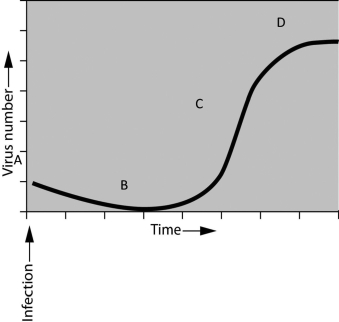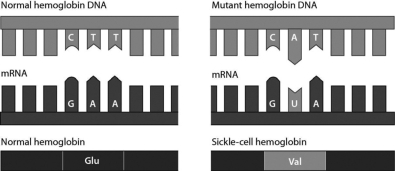A) the genetic code arose relatively late in the history of life on Earth
B) DNA replication is error-free
C) all life shares a common ancestry
D) bacterial cells arose earlier than eukaryotic cells
Correct Answer

verified
Correct Answer
verified
Multiple Choice
What is the ultimate source of all diversity?
A) natural selection
B) sexual recombination
C) meiosis
D) mutation
Correct Answer

verified
Correct Answer
verified
Multiple Choice
Peptide bonds form between ________.
A) amino acids
B) an mRNA codon and a tRNA anticodon
C) a tRNA and the amino acid it is carrying
D) an mRNA transcript and the small ribosomal subunit
Correct Answer

verified
Correct Answer
verified
Multiple Choice
If guanine makes up 60% of the bases in a DNA double helix, what percent of the bases is adenine?
A) 60%
B) 40%
C) 20%
D) 50%
Correct Answer

verified
Correct Answer
verified
Multiple Choice
What cellular structure facilitates the process of translation?
A) lysosomes
B) smooth endoplasmic reticulum
C) peroxisomes
D) ribosomes
Correct Answer

verified
Correct Answer
verified
Multiple Choice
The CORRECT sequence of events that occurs during transcription is ________.
A) splicing, adding a cap, adding a tail
B) initiation, elongation, termination
C) adding a tail, adding a cap, splicing
D) elongation, initiation, termination
Correct Answer

verified
Correct Answer
verified
Multiple Choice
Translation converts the information stored in ________ to ________.
A) DNA; RNA
B) RNA; a polypeptide
C) DNA; a polypeptide
D) RNA; DNA
Correct Answer

verified
Correct Answer
verified
Multiple Choice
Which of the following enzymes is responsible for RNA synthesis?
A) DNA polymerase
B) reverse transcriptase
C) RNA polymerase
Correct Answer

verified
Correct Answer
verified
Multiple Choice
Scenario
If you were asked to study the pattern of bacterial growth (increase in numbers over time) during an infection, you would find that numbers of bacteria increase exponentially up to a certain point. Assume that you have been asked to interpret the growth of bacteriophages. You infect the host bacteria and measure the increase of phages over a defined period of time. You plot the results and observe the graph shown here.  -Assume that you want to take a sample of viruses so that you could use them to infect the most bacteria. At what point on the graph should you take your sample from if you want to achieve this goal?
-Assume that you want to take a sample of viruses so that you could use them to infect the most bacteria. At what point on the graph should you take your sample from if you want to achieve this goal?
A) A
B) B
C) C
D) D
Correct Answer

verified
Correct Answer
verified
Multiple Choice
Plant viruses ________.
A) often use RNA, rather than DNA, as their genetic material
B) benefit plants, rather than causing disease
C) cause diseases that can be easily cured
D) do not exist, as viruses attack only animals
Correct Answer

verified
Correct Answer
verified
Multiple Choice
DNA and RNA are polymers composed of ________ monomers.
A) nucleotide
B) carbohydrate
C) fatty acid
D) amino acid
Correct Answer

verified
Correct Answer
verified
Multiple Choice
Evidence for the spiral nature of DNA came from ________.
A) X-ray crystallography studies
B) studies of disease-causing bacteria
C) bacteriophage studies
Correct Answer

verified
Correct Answer
verified
Multiple Choice
What protects mRNA from attack by cellular enzymes?
A) RNA splicing
B) the removal of exons
C) a cap and tail
Correct Answer

verified
Correct Answer
verified
Multiple Choice
Consider the following figure. It illustrates that a single amino acid substitution in the hemoglobin gene ________. 
A) always involves adenine and uracil
B) changes an amino acid in the hemoglobin protein
C) is a silent mutation
D) causes a nonsense mutation
Correct Answer

verified
Correct Answer
verified
Multiple Choice
A mutation within a gene that will insert a premature stop codon in mRNA would ________.
A) result in a longer polypeptide chain
B) result in a shortened polypeptide chain
C) change the location at which transcription of the next gene begins
D) have the same effect as deleting a single nucleotide in the gene
Correct Answer

verified
Correct Answer
verified
Multiple Choice
A(n) ________ is to bacteria as a ________ is to animal cells.
A) retrovirus; virus
B) phage; prophage
C) prophage; provirus
D) RNA virus; DNA virus
Correct Answer

verified
Correct Answer
verified
Multiple Choice
DNA contains the nitrogenous base ________ instead of ________, which is found only in RNA.
A) a deoxyribose sugar; a ribose sugar
B) uracil; thymine
C) uracil; guanine
D) thymine; uracil
Correct Answer

verified
Correct Answer
verified
Multiple Choice
If a strand of DNA has the sequence GACTTA, transcription will result in a(n) ________.
A) single RNA strand with the sequence CUGAAU
B) DNA double helix with the sequence CTGAAT for one strand and TAAGTC for the complementary strand
C) single RNA strand with the sequence CTGAAT
D) DNA double helix with the sequence CUGAAU for one strand and UAAGUC for the complementary strand
Correct Answer

verified
Correct Answer
verified
Multiple Choice
As an experiment, you infect bacteria with an unknown virus to see how the virus affects the bacteria. After a few days, you notice that the bacterial population is growing normally and that the cells appear healthy. Assuming that the infection occurred successfully, what can you conclude from your observations?
A) The virus is a bacteriophage that is reproducing via the lytic cycle.
B) The virus is a retrovirus that is reproducing via the lytic cycle.
C) The virus is a bacteriophage that is reproducing via the lysogenic cycle.
D) The virus is a retrovirus that is reproducing via the lysogenic cycle.
Correct Answer

verified
Correct Answer
verified
Multiple Choice
The absence of a terminator in transcription will result in ________.
A) a strand of mRNA that lacks its cap and tail
B) the production of a longer RNA molecule
C) the production of a shorter RNA molecule
Correct Answer

verified
Correct Answer
verified
Showing 21 - 40 of 59
Related Exams